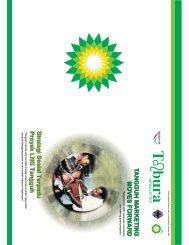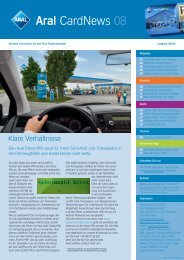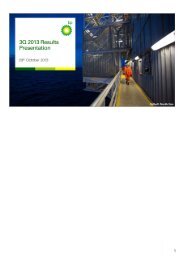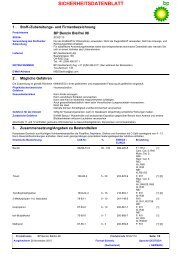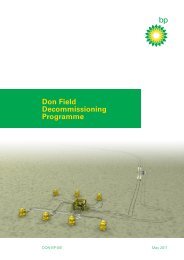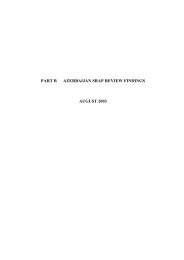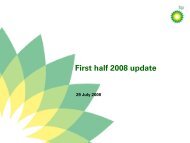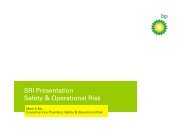Create successful ePaper yourself
Turn your PDF publications into a flip-book with our unique Google optimized e-Paper software.
In <strong>the</strong> mid-1990s, when told<br />
<strong>the</strong>y were posted to Baku to work on <strong>the</strong><br />
‘Contract <strong>of</strong> <strong>the</strong> Century’ project, many <strong>BP</strong><br />
employees responded, “Thanks, that<br />
sounds great. By <strong>the</strong> way, where is Baku?”<br />
But if Azerbaijan and its fascinating<br />
capital were not well known internationally<br />
at that time, <strong>the</strong> huge and unique Azeri-<br />
Chirag-Gunashli (ACG) oil development has<br />
put it on <strong>the</strong> map. For Azerbaijan, this megaproject<br />
has brought financial independence<br />
and a newfound confidence. For <strong>BP</strong>, in terms<br />
<strong>of</strong> project management, ACG is<br />
undoubtedly one <strong>of</strong> <strong>the</strong> most demanding<br />
projects ever undertaken.<br />
ACG followed <strong>the</strong> 1997 Chirag ‘Early Oil’<br />
project, which had demonstrated <strong>the</strong><br />
feasibility <strong>of</strong> production sharing agreements<br />
in <strong>the</strong> country. The full-field project was<br />
<strong>the</strong>n developed in three phases, starting<br />
with Central Azeri, followed by West and<br />
East Azeri, and finally deepwater Gunashli.<br />
Production began in February 2005.<br />
ACG nearly didn’t happen. As world<br />
oil prices crashed in 1998, <strong>the</strong>re<br />
were many doubts that <strong>the</strong> $10<br />
billion project would get <strong>the</strong> go-ahead. But,<br />
as one manager on <strong>the</strong> project puts it,<br />
5 billion barrels <strong>of</strong> oil reserves “were never<br />
going to be left in <strong>the</strong> ground”. ACG was<br />
sanctioned and is now making a huge<br />
difference to Azerbaijan, to <strong>BP</strong> and to world<br />
oil markets.<br />
ACG has transformed Azerbaijan’s<br />
image on <strong>the</strong> world stage, along with its<br />
economy, and was <strong>the</strong> major factor in<br />
trebling gross domestic product over <strong>the</strong><br />
project’s course. The fields produce more<br />
than 65% <strong>of</strong> <strong>the</strong> country’s oil, and during<br />
2006 and 2007, Azerbaijan was <strong>the</strong> largest<br />
contributor to non-OPEC supply growth.<br />
It is unique, but not because it pushed<br />
technological boundaries. Although it is <strong>the</strong><br />
Caspian’s only subsea development, it does<br />
not lie in <strong>the</strong> deep waters that make today’s<br />
projects in <strong>the</strong> Gulf <strong>of</strong> Mexico, or <strong>of</strong>fshore<br />
Angola, so ambitious. And its reserves are<br />
not even <strong>the</strong> biggest in <strong>the</strong> world.<br />
What distinguishes ACG is its scale. The<br />
work scope included <strong>the</strong> engineering,<br />
Long journey: <strong>the</strong> ACG complex<br />
produces <strong>the</strong> oil that feeds <strong>the</strong><br />
1,670km (1,093 mile) BTC pipeline.<br />
BLACK<br />
SEA<br />
BTC Pipeline<br />
Ceyhan<br />
Sokhumi<br />
SYRIA<br />
TURKEY<br />
Batumi<br />
RUSSIA<br />
GEORGIA<br />
Erzurum<br />
ARMENIA<br />
IRAQ<br />
Caspian report><br />
ACG mega-project<br />
fabrication, construction, installation and<br />
commissioning <strong>of</strong> <strong>of</strong>fshore drilling and<br />
production, gas compression and water<br />
injection facilities and subsea oil and gas<br />
pipelines, and <strong>the</strong> expansion <strong>of</strong> what is now<br />
<strong>the</strong> largest onshore terminal outside <strong>the</strong><br />
Middle East. Calling for six huge <strong>of</strong>fshore<br />
platforms, <strong>BP</strong>’s largest ever saturation dive<br />
programme, and an unusually large<br />
workforce <strong>of</strong> locals, <strong>BP</strong> expatriates and<br />
contractors, ACG required extensive<br />
logistical planning to realise each stage.<br />
More than 159 million man-hours were<br />
spent, 80% in Azerbaijan itself, and more<br />
than 150 million kilometres driven without<br />
major incident. At <strong>the</strong> project’s peak,<br />
catering services were dispensing 20,000<br />
meals a day to workers. Mouth-watering for<br />
<strong>the</strong> diners, no doubt, but eye-watering for<br />
those cooking.<br />
One massive fundamental challenge<br />
was where to build ACG’s huge <strong>of</strong>fshore<br />
structures. Key elements <strong>of</strong> those 233,000<br />
tonnes <strong>of</strong> infrastructure could not be built<br />
in-country. Although Azerbaijan had a long<br />
history <strong>of</strong> oil production and was <strong>the</strong><br />
centre <strong>of</strong> Soviet oil platform jacket<br />
manufacturing, its construction yards »<br />
TBILISI<br />
AZERBAIJAN<br />
IRAN<br />
CASPIAN<br />
SEA<br />
BAKU<br />
ACG<br />
Sangachal<br />
AREA<br />
ENLARGED<br />
km 150 300<br />
<strong>BP</strong> MAGAZINE Issue 1 2009 13




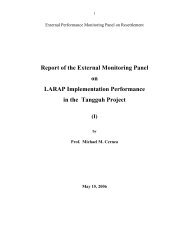
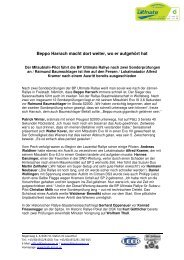
![[PDF] Deepwater Horizon: Accident Investigation Report - BP](https://img.yumpu.com/51697031/1/190x245/pdf-deepwater-horizon-accident-investigation-report-bp.jpg?quality=85)
